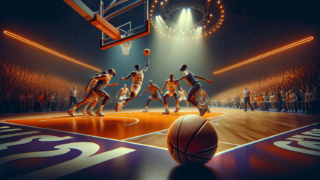
Behold the elegant reverse layup, a true spectacle of finesse and skill on the basketball court! For fans and players alike, this exhilarating move stands out as a sight to behold. In the quest to demystify the beautiful art that is the reverse layup, we present to you an all-encompassing guide into the world of this stunning basketball maneuver. Join us on this riveting journey as we delve deep into the mechanics, variations, and history that encapsulate the essence of the reverse layup. Prepare to be enlightened and entertained, all wrapped up in one fantastic package!
What’s a Reverse Layup in Basketball?
A reverse layup is an offensive move in basketball where a player drives towards the basket from one side, then jumps and spins to the other side, releasing the ball with an underhand layup. This maneuver is designed to use the hoop and the backboard as protection against shot blockers, making it difficult for defenders to interfere. Precision, body control, and timing are vital to successfully execute a reverse layup.
The Anatomy of a Reverse Layup
At its core, a reverse layup is a fundamental move in basketball that requires a combination of agility, strength, and precision. In this section, we’ll take a deep dive into the mechanics of a reverse layup, dissecting each step to truly appreciate this athletic feat.
Step 1: Drive Towards the Basket
To initiate a reverse layup, a player must first drive towards the basket. Depending on the player’s position on the court, they may need to dribble past opponents or cut through screens to get close to the hoop. This initial burst of speed is essential to generate momentum for the upcoming steps.
Step 2: Jump and Spin
Upon approaching the basket, the player must plant their foot nearest to the baseline before jumping into the air. As they do this, they should spin their body towards the opposite side of the hoop by turning their head and shoulders first, followed by their hips and legs. This stylish spin is where the true magic of the reverse layup happens.
Step 3: Release the Ball
While spinning, the player extends their arm, cradles the ball, and releases an underhand layup using a gentle touch to guide the ball off the backboard and into the hoop. Perfecting the release requires practice and an understanding of timing in order to avoid blocked shots or missed opportunities.
The Art of Balance and Body Control
One of the most challenging aspects of mastering a reverse layup is developing exceptional body control and balance – both of which are essential for executing this move with grace and skill. Here, we’ll discuss the importance of both and offer tips for improving them.
Balance Mastery
Balance plays a critical role in completing a reverse layup, as it allows for seamless navigation around defenders and smooth transitions from jump to spin. To improve balance, consider the following exercises:
- Balance board exercises
- Single-leg stability drills
- Yoga routines
- Core workouts
Body Control
Body control, on the other hand, enables a player to maintain their form and execute fluid motions throughout the entire reverse layup process. To boost body control, focus on these exercises:
- Strength training focusing on stabilizing muscles, such as squats or lunges
- Dynamic stretching routines
- Agility drills, like ladder exercises or cone drills
- Plyometric workouts to build explosive power
Variations of the Reverse Layup
Like a brushstroke on a canvas, the reverse layup can be adjusted and customized to showcase a player’s individual style and artistry. In this section, we’ll explore the various ways to spin the classic reverse layup into something unique and dazzling:
Double Clutch Reverse Layup
This variation involves tucking the ball into the chest while in mid-air and then extending for the layup. The double clutch helps evade shot blockers by altering the timing of the release and adding an extra layer of deception to the move.
Finger Roll Reverse Layup
A fusion of two classic moves, the finger roll reverse layup combines the finesse of a finger roll with the strategic spin of a reverse layup. By rolling the ball off their fingertips, the player guides the ball in a high arc, making it difficult for defenders to block the shot.
Up-and-Under Reverse Layup
This rendition of the reverse layup incorporates a fake layup on one side of the basket, usually by pump-faking or hesitating briefly, and then quickly transitioning to the other side for the actual reverse layup. This fakeout can trick defenders and create an opening for a clean shot.
The History of the Reverse Layup
Basketball, as a sport, has gone through numerous evolutions since its inception in 1891. The reverse layup is one such move that has carved out a permanent place in the heart of the game, with its captivating blend of finesse and athleticism. Let’s journey through history to understand its origins and development over time.
The Early Days
The earliest days of basketball did not feature reverse layups or many of the other acrobatic displays we see today. Instead, players primarily shot two-handed set shots with their feet firmly planted on the ground. The introduction of the jump shot in the 1930s and 1940s would pave the way for more aerial moves, laying the groundwork for plays like the reverse layup.
George Mikan: The Pioneer
George Mikan, an NBA Hall of Famer, is widely credited with popularizing the use of the reverse layup in the late 1940s and early 1950s. Standing at 6’10”, Mikan was a dominant force in the paint, and his adoption of the reverse layup – with its unique ability to protect against blocks – solidified the move’s place within basketball.
Modern Day Maestros
Over the years, numerous NBA stars have taken the reverse layup and added their own flair, turning it into a signature move. Notable examples include Michael Jordan, Kobe Bryant, LeBron James, Kyrie Irving, and Stephen Curry – each elevating the move to new heights while leaving their mark on the history of basketball.
Defending Against the Reverse Layup
As elegant and eye-catching as a reverse layup may be, it’s important to remember that basketball is a two-sided game, encompassing both offense and defense. As such, understanding how to defend against the reverse layup is equally as important as being able to execute one. Here’s how defenders can disrupt this spectacular move:
Anticipate the Move
One of the key aspects of defending is learning to read and anticipate an opponent’s intentions. By studying your opponent’s tendencies, you can determine when they may attempt a reverse layup and react accordingly.
Maintain Proper Positioning
Defenders should strive to stay balanced and maintain an optimal position between their opponent and the basket. By doing so, they can hinder the offensive player’s path to the hoop, forcing them to reconsider the reverse layup or make adjustments that could lead to mistakes.
Master the Art of Shot Blocking
While reverse layups are designed to thwart shot blockers, this doesn’t mean it’s impossible to swat one away. Mastering the timing and trajectory of your shot-blocking technique can help you contest and potentially alter a reverse layup attempt.
Practice Makes Perfect: Drills to Improve Your Reverse Layup
Becoming an expert at the reverse layup requires consistent practice and refinement of your skills. Here are a few drills to help you hone your technique and boost your confidence in executing this remarkable move:
Mikan Drill
This fundamental drill was designed by George Mikan himself, focusing on footwork, timing, and shooting with both hands. Standing directly under the basket, shoot a layup using your right hand, retrieve the ball as it drops through the net, and then shoot a layup with your left hand. Continue this pattern while emphasizing proper footwork and rhythm.
Reverse Layup Ladder Drill
In this drill, place a ladder or use tape to create a ladder-like pattern on the floor leading up to the baseline. As you approach the basket, step through each rung of the ladder, focusing on your footwork and agility. At the end of the ladder, explode towards the hoop and finish with a reverse layup.
Two-on-One Drill
This drill simulates a game situation by having you drive to the basket against a defender. As the offensive player, work on using the reverse layup to evade the shot-blocker and maintain control in the presence of defensive pressure.
With a combination of diligence, practice, and a touch of finesse, the reverse layup can become a beloved weapon in your arsenal on the basketball court. By studying its history, mechanics, variations, and defensive strategies, you’ll be well-prepared to take your skills to new heights and dazzle your opponents with this showstopping move.
Galvanizing Your Mental Game
Basketball is more than just a physical sport; it also demands mental fortitude, focus, and decision-making abilities. As you tackle the reverse layup, consider these important mental aspects:
Develop Basketball IQ
Understanding the nuances of the game will allow you to identify opportunities for a reverse layup and anticipate defensive tactics. Increasing your basketball IQ involves studying the game through watching games, analyzing plays, and learning about various strategies.
Visualize Success
Visualization is a powerful technique used by many athletes to improve their performance. Mentally rehearsing the execution of a reverse layup can help solidify your technique and boost your confidence during the heat of a game.
Remain Adaptable
In basketball, situations on the court are constantly shifting. Emphasize adaptability in your game, particularly when executing a reverse layup. This means staying attuned to what’s happening around you, reading the defense, and adjusting your movements accordingly.
Reverse Layup Applications in Different Scenarios
Knowing when to use a reverse layup can make all the difference in the effectiveness of your offensive moves. Here are some scenarios where the reverse layup might come in handy:
Fast Breaks
On a fast break, defenders often scramble to get into position, creating opportunities for you to take advantage of the chaos and slip in a reverse layup. The added difficulty in defending this move might be all it takes to secure the basket.
Beating Shot Blockers
If your opponent is an adept shot blocker, using a reverse layup can help evade their attempts to swat your shot away. The reversal motion places the basket and backboard between the ball and the defender, shielding your shot from their reach.
Attacking the Defense’s Weak Side
When defensive coverage is particularly tight on the strong side of the court, attacking from the weak side with a reverse layup can create an opening to score. The swift motion and spin work to keep you ahead of your defender, thus ensuring the success of your move.
Reverse Layup in the Women’s Game
The reverse layup is not exclusive to the men’s game. Many female basketball players have embraced this move and added it to their skillsets. In the WNBA, players such as Candace Parker, Diana Taurasi, and Sue Bird have showcased their proficiency in executing reverse layups, showcasing its versatility and utility across both the men’s and women’s games.
With determination and consistent practice, the reverse layup can become an invaluable addition to your basketball repertoire, regardless of your gender or skill level. Embrace this captivating move and transform your game into a mesmerizing display of agility and finesse.
Frequently Asked Questions
Curiosity has driven you to better understand the reverse layup and its many nuances. In this section, we address some common questions and provide clear, concise answers to help expand your knowledge of this fascinating basketball move.
1. Why should I use a reverse layup instead of a regular layup?
A reverse layup offers several advantages over a regular layup, such as increased protection against shot blockers due to the positioning of the basket and backboard, and its unpredictability, which can catch defenders off-guard.
2. Which hand should I use when attempting a reverse layup?
As a general rule, use the hand farthest from the basket when executing a reverse layup. This helps maintain better control of the ball and further shields the shot from defenders.
3. When should I execute a reverse layup during a game?
Optimal times to attempt a reverse layup include fast breaks, when defensive coverage is tight on the strong side of the court, when facing a skilled shot blocker, or to catch defenders off-guard with an unexpected move.
4. How do I improve my balance for a reverse layup?
Enhance your balance by practicing balance board exercises, single-leg stability drills, yoga routines, and core workouts.
5. How can I master body control for a reverse layup?
To improve body control, focus on strength training that targets stabilizing muscles, dynamic stretching routines, agility drills, and plyometric workouts.
6. Can I use a double clutch with a reverse layup?
Yes, you can incorporate a double clutch with a reverse layup to further deceive defenders and alter the timing of your release, making it more difficult to block.
7. Are there any famous reverse layup highlights that I should watch?
Some unforgettable reverse layup moments include Michael Jordan’s clutch reverse layup during the 1991 NBA Finals, and Kobe Bryant’s iconic reverse layup against the New York Knicks in 2009. Watching these highlights can offer both inspiration and a better understanding of the move.
8. How can I practice a reverse layup without a basketball hoop?
Even without access to a basketball hoop, you can work on the individual components of a reverse layup, such as footwork, jumping, and spinning techniques. Additionally, practicing visualization techniques can help solidify your mental grasp of the move.
9. Can shorter players use reverse layups effectively?
Absolutely! While taller players may have a natural advantage when attempting layups, shorter players can effectively use reverse layups by focusing on developing their agility, speed, body control, and deception techniques.
10. How do I defend against a reverse layup?
To counter a reverse layup, anticipate your opponent’s intentions, maintain proper positioning between the offensive player and the basket, and master the art of shot blocking.
11. Are there any differences in executing reverse layups among various basketball leagues?
While the basic mechanics remain the same, the level of competition may impact the speed, precision, and complexity of reverse layups. Elite leagues like the NBA will feature more advanced variations and require greater skill to execute the move successfully.
12. Can a reverse layup be used as a go-to move?
A reverse layup can certainly be a go-to move if mastered and used strategically. However, relying solely on the reverse layup may limit your offensive versatility, so it’s essential to develop a range of moves to keep defenders guessing.
13. How important is footwork in the execution of a reverse layup?
Footwork is crucial in performing a reverse layup, as it sets the stage for a strong takeoff, the spin in the air, and a secure landing. Proper footwork can improve power, accuracy, and control during the entire move.
Featured Posts
- No pillar pages found.





